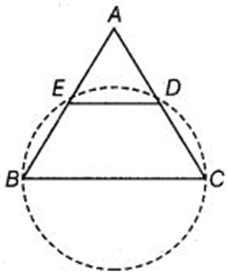If a line is drawn parallel to the base of an isosceles triangle to intersect its equal sides, prove that the quadrilateral so formed is cyclic.
Given: ABC is an isosceles triangle such that AB = AC and ED ∥ BC.

To prove: Quadrilateral BCDE is cyclic, ie. sum of opposite angles is 180°.
In ΔABC,
AB = AC (Equal sides of the isosceles triangle)
⇒ ∠ABC = ∠ACB (angles opposite to equal sides are equal)
As ED ∥ BC, therefore,
∠ADE = ∠ACB (corresponding angles)
Adding ∠EDC on both sides, we get:
∠ADE + ∠EDC = ∠ACB + ∠EDC
⇒ 180° = ∠ACB + ∠EDC
⇒ 180° = ∠ABC + ∠EDC (∵ ∠ACB = ∠ABC)
Sum of opposite angles of quadrilateral is 180°.
⇒ Quadrilateral BCDE is cyclic.
Hence, proved.
11